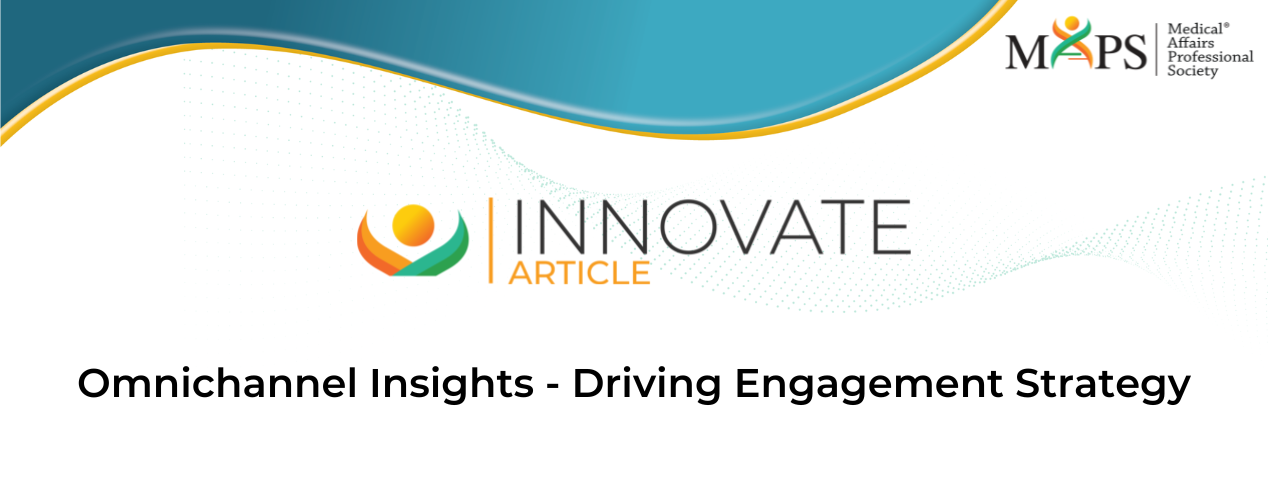Omnichannel Insights – Driving Engagement Strategy
The MAPS Insights Focus Area Working Group holds informal, bi-monthly, open-access, virtual forums to discuss topics relevant to the strategy and practice of Medical Affairs insights management.
This article summarises highlights key learnings from the “Omnichannel insights- Driving engagement strategy” forum.
Omnichannel Insights
Medical Affairs gathers insights from internal and external sources and disseminates them cross functionally to drive many different applications – evidence generation planning, content development, HCP engagement, customer targeting, and strategy development.
If, in this context, an ‘insight’ is a novel piece of knowledge or perspective that stimulates a new way of thinking and suggests action, then an omnichannel insight is one which specifically drives an integrated HCP engagement strategy.
Omnichannel insights help govern your omnichannel strategy and tactics. They help direct how you engage with different types of audiences, through which channels, and with which messages.
Product Vs Customer
In the typical multichannel model we create for our customers, the focus is often around the ‘product’ and a significant proportion of insights collected by an organisation will be product-focused with a view to guiding medical strategy and product utilisation.
This may happen across the entire product life-cycle even though we associate specific types of insight with specific time points e.g. a focus on evidence generation occurs during a specific product life-cycle phase.
In an omnichannel model, however, the focus is the ‘customer’ – an integrated seamless customer experience that’s driven by their needs and preferences. A shift to omnichannel allows for the customer to become an additional area of focus.
Scientific Communication
Given that the future of scientific communication is bidirectional, on-demand, multi-channel, and very much customer-led, then embracing an omnichannel strategy driven by omnichannel insights is a pre-requisite to scientific communication success.
In such a future where your customers and stakeholders can consume and hear your story slightly differently to each other, omnichannel insights are an important avenue to help achieve the “right message, right time, right channel, right audience” goal.
But within this future scientific communication scenario, it’s equally important to address not just the HCP but also the wider disease community and connected ecosystem.
For example, how does the consumption of a piece of content by an HCP then dictate who that HCP connects with next – either within or outside their peer group / community? Because the network of relationships in itself constitutes a potential ‘channel’ in its own right.
A good omnichannel strategy therefore aim to impact the whole community, the entire ecosystem in which your therapy exists.
Engagement Strategy
Your engagement strategy is informed by many inputs e.g. what can you learn from the omnichannel journey experienced by an individual HCP? How do you know what you should do next time? And when exactly is “next time” – is it driven by you or by the needs of your HCPs/stakeholders?
Omnichannel insights can guide you on the best ‘direction-of-travel’ to take i.e. what will work better next time. Therefore, underpinning your content strategy with omnichannel insights enables you to refine your engagement strategy and to amplify your voice.
Take the example of a Congress, where the potential channels for interaction, the opportunities for content creation, and the ability to react to data are numerous (and ever expanding).
Omnichannel insights that encompass all these variables can tell you not just about HCP behaviour but also about the best way to allocate your resources, whether in the actual congress or through post-event follow-up channels. A congress is therefore an ideal situation to try an “omnichannel insight-first” strategy.
Another example would be when deciding what an organisation should do to address the reaction of its customers to new data releases, publications, and conferences.
In these situations, omnichannel insights allow the organisation to react and more accurately adjust its content and communication strategy in line with HCP understanding, reaction, and consumption.
Implementing Omnichannel Insights
Omnichannel requires many coordinated cogs to work together – CRM, Med Info, congress activity reports, social listening – all represent important sources of insights that you most probably already have in place, and from which you can create an effective omnichannel insight collection strategy.
Further layers can be incrementally added onto your omnichannel insights collection process over time e.g. HCP preference data on how they want to interact with you can serve as an additional fine-tune when delivering your omnichannel strategy.
And because, thanks to omnichannel insights, you are now able to visualise how your customers are moving through each channel, what journey they take with your content, what they want more of, and how they want it, developing the next iteration of your engagement strategy becomes more efficient and efficacious.
An omnichannel insights process should be a living, breathing, continually evolving system. Just like the needs of your customers.
Contributors
Author:
Contributors:
Carole Catapano



